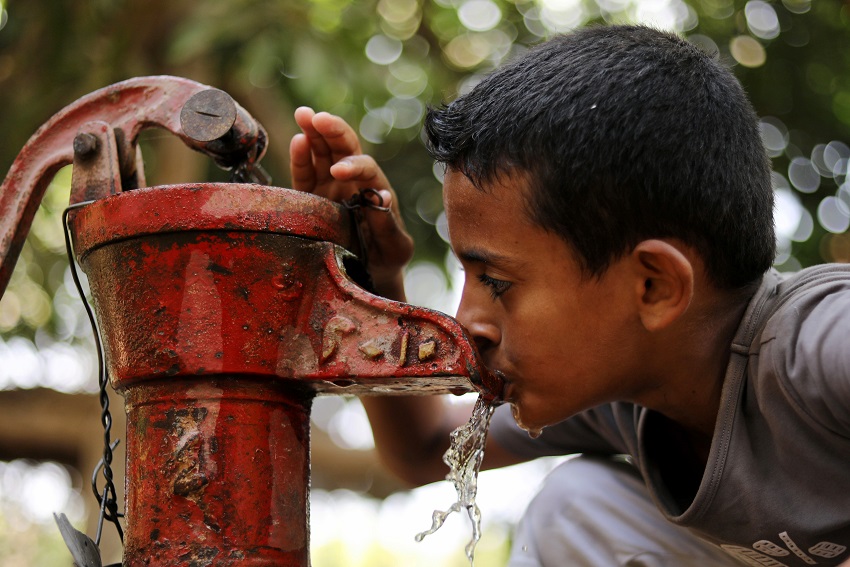11 February 2019
Another drop in the ocean
The decline in supplies of drinking water remains a serious problem that affects every continent
Water continues to decline while drinking water is still a mirage for millions of inhabitants of our planet. We must make investments and protect the environment. But also promote awareness campaigns and new cultural behaviours.
In August 2017, a team of researchers from the Technical University of Vienna announced that they had created the cleanest drop of water in the world. This ultra-pure water could help to explain how self-cleaning surfaces, such as those coated with titanium dioxide (TiO2) - a chemical composition in the form of a colourless crystalline powder - become covered by a strange layer of molecules when they come in contact with air and water.
Do not be misled by this news. It is an important discovery for the scientific community but it is not exactly what we mean by clean water, that is, uncontaminated water. This is one of the biggest problems in the world and represents a public health issue not only in developing countries, where access to water is generally still a problem.
The United Nations estimates that water scarcity affects more than 4 in 10 individuals around the globe. Although a third of the world’s inhabitants have obtained access to better sanitation services in the last thirty years, the decline in supplies of drinking water remains a serious problem that affects every continent. In recent years, several countries have experienced what is defined as “water stress” and the increase in droughts and desertification is exacerbating a situation that, by 2050, could result in at least 1 out of every 4 people being affected by recurring water shortages.
If more than 2.5 billion people have obtained access to sanitation services and better sources of drinking water, 2.4 billion people worldwide have no access to basic sanitation services such as toilets or latrines. And well over 650 million people are completely without access to this basic need, a problem that results in women in sub-Saharan Africa spending about 40 billion hours per year collecting water, which has a significant impact on their job opportunities and, therefore, the economic development of their communities. Each day, about 1,000 children still die from preventable diseases related to water and sanitation. Yet the solution may not be far off, if we consider that 80% of wastewater from human activities is discharged into the waterways without any removal of the sewage that then pollutes groundwater.
Ensuring universal access to safe, affordable drinking water for all people by 2030 is one of the commitments that the international community undertook in 2015 with the 17 Sustainable Development Goals (SDGs), one of which regards water. A goal that requires that we invest in adequate infrastructures, sanitation services, and hygiene campaigns as a positive cultural model. However, we must also protect and restore water-related ecosystems - forests, mountains, wetlands and rivers - to combat and mitigate water scarcity. Lastly, a greater level of international cooperation is also needed to encourage water efficiency and support wastewater treatment technologies, particularly in developing countries.
The World Health Organization (WHO) has noted that the most significant progress has been made in East Asia, where the coverage of sanitation facilities has increased from 27% to 67% over twenty years (from 1990 to 2011), which equates to better access to sources of drinking water for an additional 600 million people. In South Asia, India has made remarkable progress by providing stations and public places with micro-filtered water dispensers. But open defecation is another enormous problem, still practiced by 1 billion people, i.e. 15% of the world population. Most of these people live in rural areas and 90% of all cases of open defecation occur in rural areas. Nevertheless, open defecation rates declined globally from 24% in 1990 to 15% in 2011. But if the problem in Asia has declined (as a result of increased services but also awareness campaigns regarding the risks of this practice) in sub-Saharan Africa the number of people who defecate in the open is still increasing (one gram of faeces may contain up to 10 million viruses and bacteria).
Once again the Indian government, with UNICEF and other partners, is taking the challenge extremely seriously and has the goal of making India “Open Defecation Free” by 2019 through awareness campaigns, information sharing, and creating behavioural change. To save groundwater, it is not sufficient to invest in structures: changing behaviours is an equally important breakthrough.

